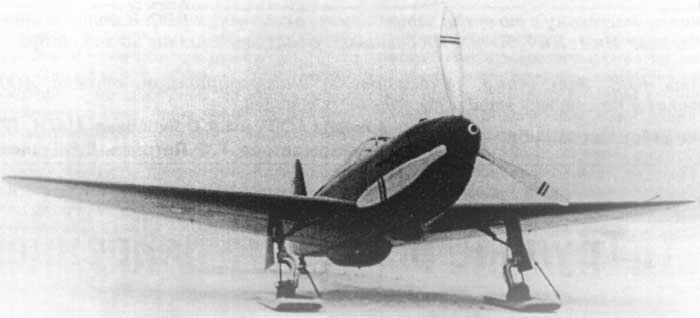
Experimental fighter I-26

History
The history of a series of WWII Yakovlev fighters dates back to early 1939 when Yakovlev's design bureau started to work on a new generation of fighters. The I-26 test fighter was designed in May-August 1939, and the first example I-26-1 was build in December 1939. Test pilot Yu. Piontkovsky performed the first test flight on I-26-1 in January 1940. The plane reached the speed of 586 km/h at the 5100m altitude.
Despite the fatal accident with I-26-1 on 27 April 1940, which completely destroyed the plane and killed the test pilot Yu. Piontkovsky, test flights demonstrated good overall performance of the aircraft. In December 1940 the fighter was recommended for serial production and given the name Yak-1. I-26 became a prototype for all subsequent types, which reproduced its basic design, size and construction technology.
Construction and technology
The aircraft was designed aiming to maximise the use of cheap and ready available construction materials. This proved later to be a significant advantage for serial production of planes under the economical stress imposed by the war.
The I-26 was a low-wing monoplane of a mixed construction.
The fuselage frame and engine mounting bed were made from steel tubes connected by welding. The front and middle fuselage skin was a light alloy (duralumin) sheeting. Plywood and canvas were used as a covering of the rear fuselage. The cockpit was protected on the back side with an 8 mm armour, and had a three-section razor-back canopy.
The wing frame consisted of two timber spars and truss ribs (airfoil Clark YH), sheeted by plywood with canvas glued on the top, coated with a filler and polished. The stabiliser and tail were of a timber-plywood construction. The control surfaces were duralumin frames covered with canvas.
The plane was powered by V.Klimov M-105P V-12 liquid-cooled supercharged engine delivering 1050 hp at the 4000 m altitude and a three-blade variable-pitch propeller VISh52P with a diameter of 3 m. Four protected fuel tank with a total capacity of 410 l (305 kg) were installed in the wing.
The plane had a three-point retractable landing gear with front weels locked up in a compartment in the middle wing and a free-turn rear weel. The photo at the top depicts the winter season version of the landing gear with landing ski instead of weels, since first flights were done in January 1940.
The armament (I-26-1) included one motor-mounted 20 mm cannon ShVAK (130 rounds of ammunition) and 4x7.62 mm machine gans ShKAS (1070 rounds).
Variants.
There were three I-26 planes build.
The I-26-2 construction was finished in April 1940. Minor changes and improvements introduced on I-26-2 included 2 ShKAS machine guns (I-26-1 had 4) and reduced ammunition supply (120 rounds for cannon and 760 rounds for machine guns) , propeller VISh61P, oil radiator placed under the engine.
The I-26-3 was comleted in September 1940. It was similar to I-26-2 except of enforced wing and landing gear construction and ammunition supply (135 rounds for cannon and 1500 rounds for machine guns). It was heavier than its predecessors by 100 kg.
For the purpose of training pilots to fly fighters of the new generation, a two-seat variant of the I-26 was developed named I-26UTI (also known as I-27). It was a dual-control airplane with reduced area of the control surfaces and changed aerodynamic balance for easier control by beginner pilots. The aircraft was given a name Yak-7UTI in the serial production. Later in 1941 the Yak-7UTI aircraft was converted to a combat fighter, and this series became known under the name Yak-7.
| Engine | I-26-1 | I-26-2 |
| Wing span, m | 10.0 | |
| Length, m | 8.48 | |
| Height, m | 2.64 | |
| Wing area, sq m | 17.15 | |
| Engine | M105P | |
| Engine power, hp | 1050 | |
| Empty weight, kg | 2200 | |
| Take off weight, kg | 2700 | |
| Max speed at ground level, km/h | 490 | |
| Max speed, km/h (at altitude, m) | 586 (5100) | |
| Range, km | 700 | |
| Climb speed m/min | 833 | |
| Max altitude, m | 10200 | |
| Armament | 1x20
mm cannon ShVAK 4x7.62 mm machine guns ShKAS |
1x20
mm cannon ShVAK 2x7.62 mm machine guns ShKAS |